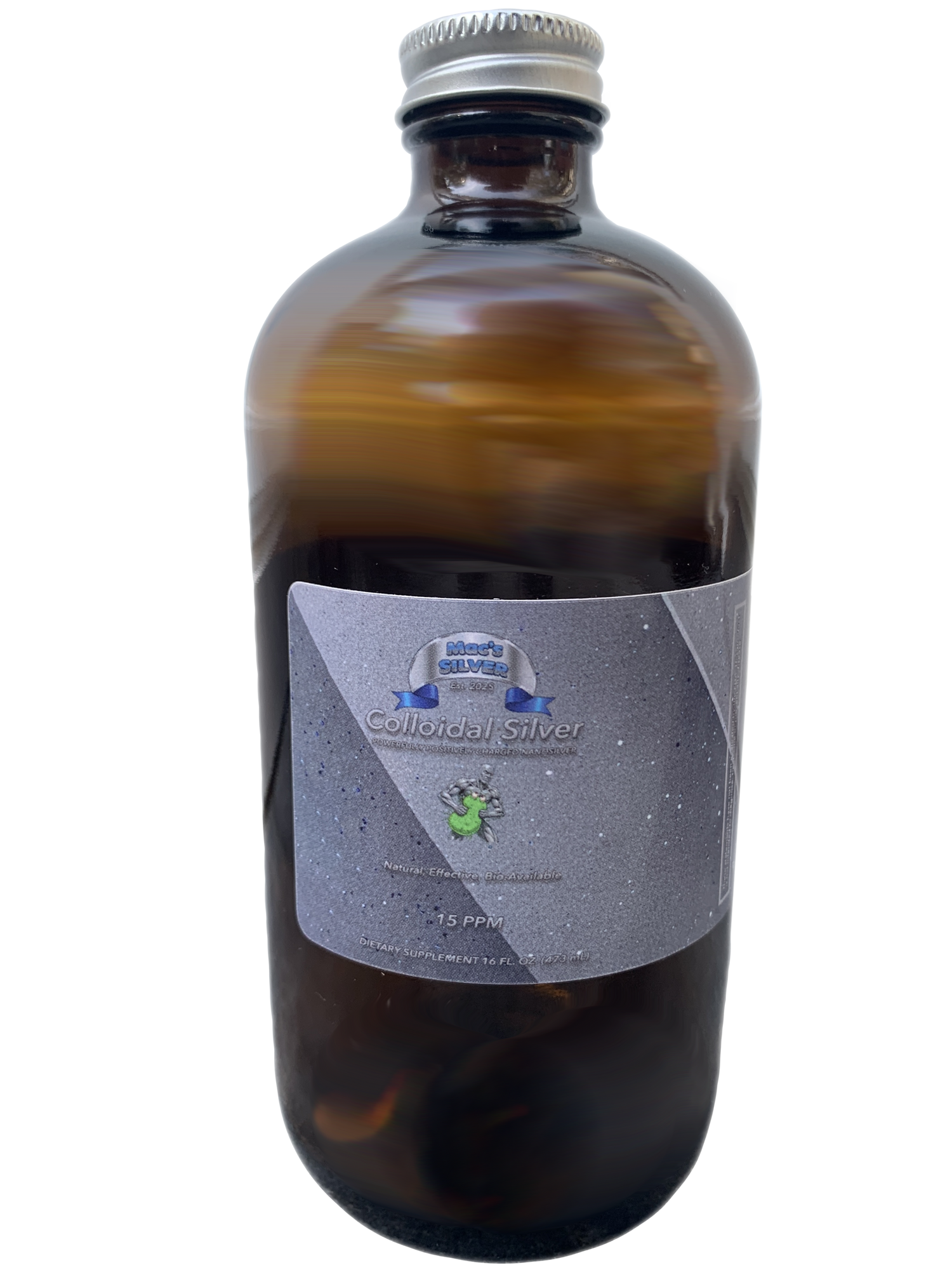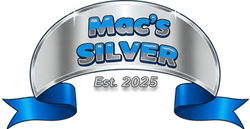Mac's Silver
Pure: This product contains only 99.99% pure silver and distilled water, no additives. It’s also bottled in glass, never plastic.
Uses: Can be applied topically to infected areas or wounds as well as taken orally to promote immune response.
How It Works: Colloidal Silver is positively charged nano sized silver particles suspended in distilled water which does 3 things.
It connects to the cell membrane of negatively charged bacteria, viruses & fungi then disturbs the integrity of the cell membrane by rupturing it.
It disrupts the organisms ability to perform metabolic functions.
It also produces reactive oxygen species which causes oxidative stress within microbial cells which ultimately leads to cell death.
Colloidal Silver: The Complete Historical Summary
What it is:
Colloidal silver is a liquid containing tiny particles of pure silver suspended in water. It has been historically used as an antimicrobial treatment. Long before antibiotics were discovered, humanity looked to the shimmering magic of the natural world—and few elements held the mystique, reverence, and healing reputation quite like silver. From ancient empires to 20th-century operating rooms, colloidal silver once stood tall as a medical marvel.
Ancient to Pre-Modern Use
Ancient Civilizations (pre-1000 CE):
Silver’s antibacterial properties were no secret to the ancients. As early as 400 BCE, Hippocrates, the father of modern medicine, wrote of silver’s healing properties for wounds and ulcers. Ancient Persians, Greeks, and Romans used silver vessels to keep liquids pure and prevent spoilage. Soldiers would place silver coins in water and milk to prevent it from turning foul—an early form of water purification.
- Middle Ages (1000–1600 CE):
During the Black Death (1347–1351), European nobility—who often used silver cutlery, drank from silver goblets, and stored food in silver containers—were observed to have lower death rates. Coincidence? At the time, it was interpreted as yet another divine sign of silver's protective aura. European elites used silver utensils and storage containers, which helped reduce bacterial contamination. The term "blue blood" may stem partly from argyria (a blue-gray skin condition caused by silver exposure).
Emergence of Colloidal Silver (1890s–1930s)
Late 1800s:
Scientists developed colloidal silver as a more precise antimicrobial solution. It was used in medicine to treat bacterial infections before the antibiotic era. In the late 19th century, colloidal silver was born—tiny, electrically charged particles of silver suspended in distilled water. This innovation allowed silver to be ingested or injected with precision, and it quickly became a cornerstone of early modern medicine.
- 1910s–1930s:
By the 1910s, colloidal silver was hailed as a broad-spectrum antimicrobial. It was widely used to treat: Pneumonia, syphilis, gonorrhea, sepsis, wounds and burns, and eye infections. Products like Argyrol became common in hospitals. Medical journals from the 1920s and 30s sang its praises. It was marketed as Argyrol, Collargol, and under other brand names—administered by the best physicians of the day. The prestigious Lancet Medical Journal wrote glowingly of silver nitrate and colloidal silver’s ability to fight infection. Even Dr. Henry Crookes, a pioneer in bacteriology, declared in 1910 that silver was “absolutely harmless” and “highly germicidal.” In 1938, the U.S. Food, Drug, and Cosmetic Act reclassified many treatments, and with the rise of penicillin.
Decline in Medical Use (1940s–1970s)
1940s:
The introduction of penicillin and other antibiotics led to a sharp decline in colloidal silver use in mainstream medicine. In the 1940s, colloidal silver fell out of favor. The pharmaceutical world turned to synthetic antibiotics—and the shimmering silver solution faded into obscurity.
- 1970s:
Medical regulation increased. Silver-based treatments were replaced by more targeted pharmaceuticals. Side effects like argyria were better understood.
.
Modern Use and Regulation (1980s–Present)
1980s–1990s:
Colloidal silver re-emerged in alternative health circles, marketed as a natural immune booster or antimicrobial. Used for everything from cold prevention to topical healing.
- 1999:
The U.S. FDA ruled that colloidal silver is not safe or effective for any over-the-counter therapeutic use. It cannot be marketed as a cure or treatment for any disease.
- Today:
While modern medicine warns of risks like argyria (a rare but permanent blue-gray discoloration of the skin from overuse), fans of colloidal silver swear by its powers. Its advocates hail it as a natural antibiotic, a miracle mineral, and a forgotten treasure.
From the temples of Hippocrates to the shelves of 21st-century health stores, colloidal silver remains one of history’s most intriguing medical stories—a gleaming reminder of how ancient remedies can echo through time.
However, medical-grade silver is still used in:
- Wound dressings
- Burn treatments
- Coatings for catheters and medical devices
Summary
🎉 Why Choose Colloidal Silver Today?
- 🌿 Natural Alternative to synthetic antibiotics
- 🔒 Immune Support like your ancestors relied on
- 💧 Easy to Use – just a few drops a day!
- 🛡️ Broad-Spectrum Protection – the silver shield of wellness!
.
High-profile advocates like NASA and Russian cosmonauts used silver-based systems to purify water in space. In hospitals, silver-infused wound dressings and catheters became common again, proving that the metal’s antimicrobial legacy endured.
From ancient empires to cutting-edge space tech, colloidal silver has stood the test of time. Now, it’s your turn to unlock its legacy.
✨Colloidal Silver – The Shimmering Secret of the Ages, Bottled Just for You.✨
Mac's Silver



